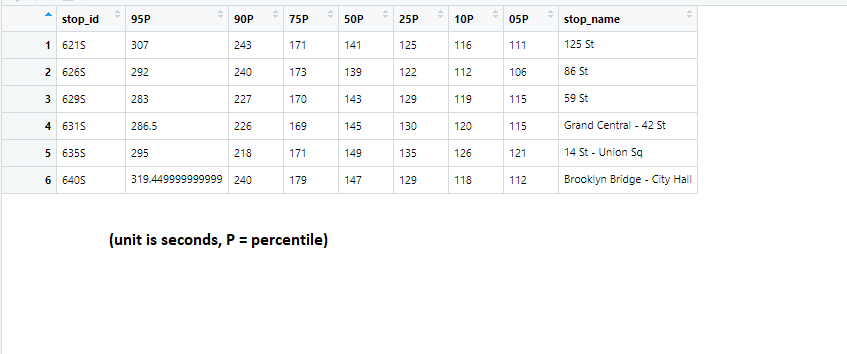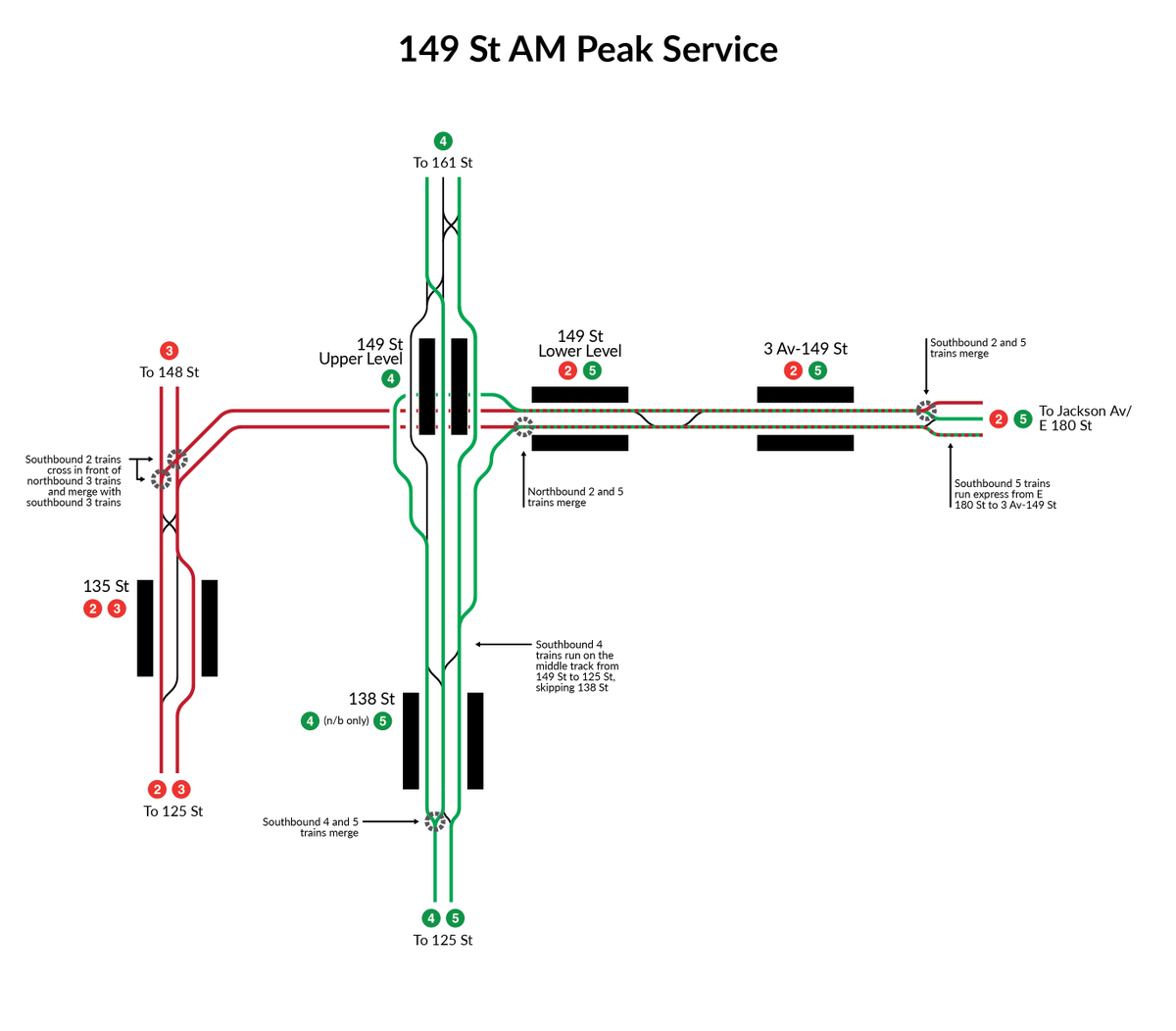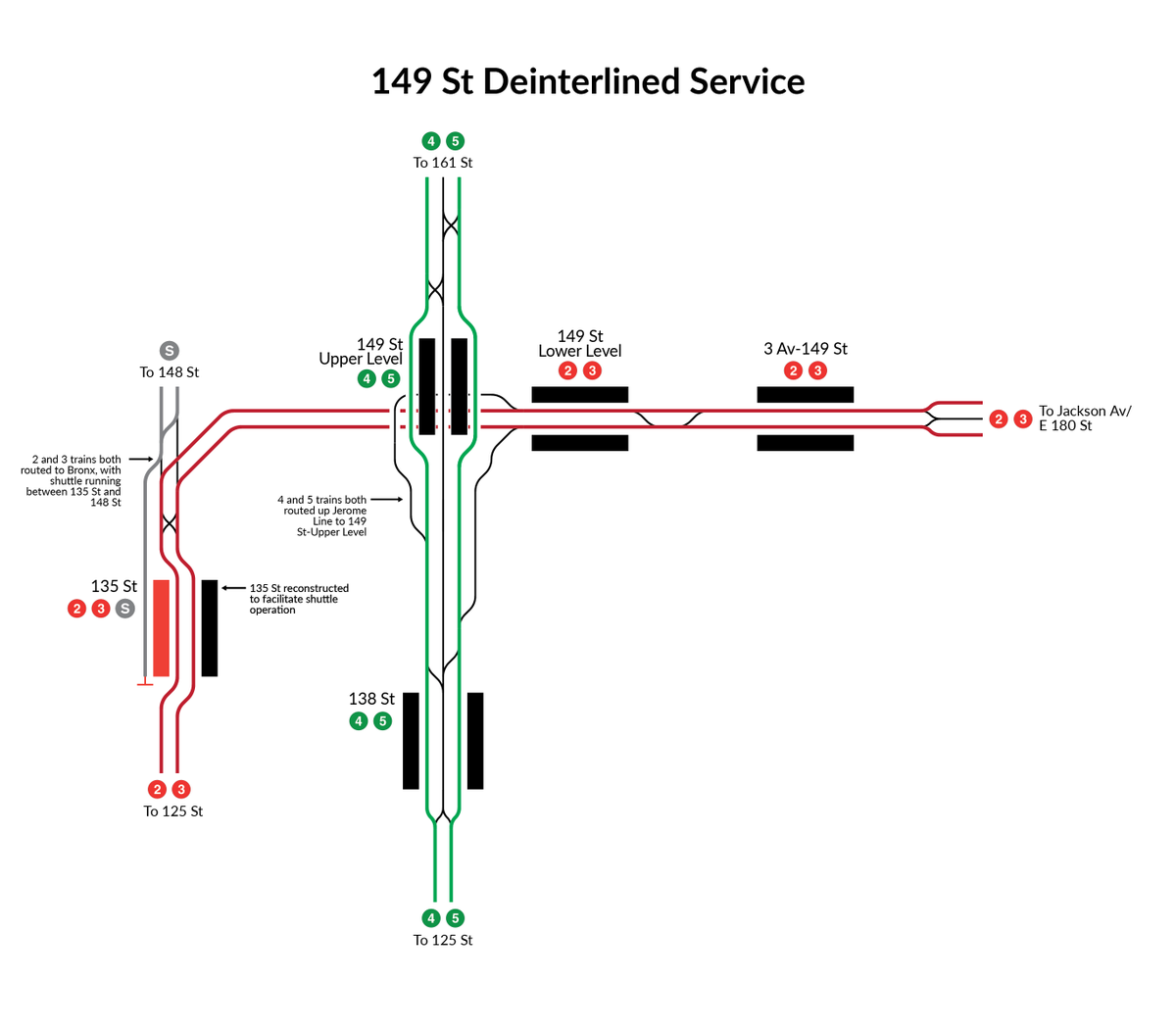Folks, it& #39;s time to talk about Nostrand Junction& #39;s evil cousin: 149 St. This will be a long thread.
When one looks at a chart comparing peak hour 4 and 5 train runtimes to midday & #39;base& #39; values, a lot of what you see is expected: trains move much more slowly around Grand Central and 14 St during the peak than in the off peak.
But then there& #39;s the 149 St area. It& #39;s INSANELY bad. Despite the fact that southbound 4 trains skip 138 St during rush hours, 4 runtimes from 149 to 125 are fully 50% higher during the AM peak than they are off peak. On the 5, 138-125 takes about 60% longer peak vs off peak.
(PM peak is much better; the peak in 4 runtimes is likely because of the diverging move from the middle to n/b local track which slows things down a bit)
So what the hell is going on here? While 125 St -- the south end of the poorly performing stretch -- certainly sees extended rush hour dwells, they aren& #39;t as long as those seen further down Lex, nor do those other high-dwell stations cause nearly this magnitude of peak hour delay
Now, dwells do not a disaster make; the vagaries of an area& #39;s signaling can greatly aggravate (or attenuate) their impacts. Those nuances are especially important given just how heavily modified NYCT& #39;s signals have been.
To get a more holistic read on performance, I like to look at min. delivered headways, as finding the highest minima is a decent heuristic for finding areas under the most operational stress. Here& #39;s Lex in the AM peak; note that 125 delivers lower minimums than most others
In other words, what makes this stretch bad must not just be a signalling-dwell issue, but it + something else. My best guess is that something else is the stretch& #39;s merge
A quick bit of background on the area: the 149-125 stretch of railroad is v complex. It& #39;s where the 2, 4 and 5 get sorted onto their Bronx trunks, and the junction btwn the 2 + 3 isn& #39;t all that far away. These 3 maps show how it& #39;s run in the AM peak, off peak and PM peak periods:
Poor southbound 4/5 performance seems to be linked to the AM peak presence of a merge between 4 and 5 trains just south of 138 St, at the bottom of the map.
Logically, the merge between 4 and 5 trains at 138 shouldn& #39;t be that bad: both routes are still relatively close to their northern terminals, meaning schedule adherence should be decent, and while the 5& #39;s route involves a merge with the 2 and a buncha timers...
...much worse than this is handled more elegantly in the system. But alas, not here.
Aggravating the area& #39;s service complexity are a number of other topological factors. For one, the signal system approaching/in 149 St southbound for 2/5 trains restricts capacity--note it& #39;s the highest min headway of the 2/5 shared segment in both the AM + PM peaks
This limitation isn& #39;t directly implicated in the merge delays between 138 and 125, but the forced conformity of service headway to the limitations of the area signal system can throw trains off schedule by enough to cause a 5 to be late arriving at the merge point with the 4.
The extremely curvy and slow stretch of track that 5 trains must traverse immediately after 149 St doesn& #39;t help matters, either: you get a slow diverging move leaving 149 Lower and a decent bit of runtime variability
Beyond those two issues, you also have:
- A series of nasty timers for 4/5 trains heading downhill into 138 St
- Extremely slow (10 mph) timers just before the switch where AM peak 4 trains merge with the 5
- A lack of speed signage for 4 trains over that merge
- A series of nasty timers for 4/5 trains heading downhill into 138 St
- Extremely slow (10 mph) timers just before the switch where AM peak 4 trains merge with the 5
- A lack of speed signage for 4 trains over that merge
- Scheduled headways that aren& #39;t deliverable (note the number of 90 second intervals scheduled between 2 and 5 and 4 and 5 trains during the AM rush and compare with the charts of minimum headways upthread):
- A fixed minimum dwell time of 30 seconds for southbound 5 trains at 149 St lower thanks to that interlocking& #39;s architecture (NYCT is developing an interesting mitigation for this)
Add these together, and add the normal schedule jitter caused by variable conductor and train operator performance across multiple stops, and voila, you get merge delays.
So what do we do?
Signaling improvements could have a real impact, especially relative to the 149-Lower issues and the presence of timers. On the cheaper side, following through on NYCT& #39;s proposed improvements to the area (see: #page=168">https://new.mta.info/sites/default/files/2019-12/MTA%20NYCT%20Subway%20Speed%20and%20Capacity%20Review_Final%20Report.pdf #page=168)">https://new.mta.info/sites/def... could ameliorate the minimum 5 dwell problem
Using axle counters to retrofit increased flexibility into the 149-LL signal system could also be valuable. Based on my observations, a nontrivial component of the issue at that location is the fact that trains are held 700& #39; back from 149 lower when their leader is in the station
Closing that distance (the downgrade is, IINM, <1%) could improve capacity there, and help mitigate the (relatively insoluble) issue of the slow diverging move that 5 trains take by allowing 2s to creep up closer more quickly.
CBTC installation through the entire area would, of course, do all of this and more, and should absolutely be pursued. But given current budgetary issues...................
By far the highest return action you could take for area fluidity is deinterlining 149 St. This would entail:
- Converting 145 and 148 Sts to shuttle operation
- Rerouting the 3 to Dyre Avenue
- Rerouting the 5 to, say, Burnside Avenue
- Converting 145 and 148 Sts to shuttle operation
- Rerouting the 3 to Dyre Avenue
- Rerouting the 5 to, say, Burnside Avenue
On a tracks level, that& #39;d look like this:
I don& #39;t want to underrate how heavy a lift this would be. Obviously the politics of adding transfers and converting stops to a shuttle are difficult, especially given the corridor that& #39;d be receiving the most new service (Jerome) already has two subway corridors...
...but there& #39;s an infrastructure challenge, too. The lower level platforms and passageways at 149 St are extremely cramped, and get really crowded even with current service configurations.
Rerouting 5 service means that all the folks you see commuting to the E Side/LIC on this map would be making that transfer. You& #39;d need to massively invest in station capacity so that movement doesn& #39;t become a public safety hazard.
Would it be worth it? Quite possibly yes, especially given that this& #39;d also eliminate a nasty flat junction between the 2/3 trains north of 135 St, enabling that corridor to up its throughput. But it& #39;d be a lift.
Obviously, these gains wouldn& #39;t be worth all that much absent changes at Nostrand Junction, as well as smaller tactical ops improvements to such things as dwell times in Midtown, signal systems in Lower Manhattan, etc.
But 149 St in my mind is a poster child for New York& #39;s issues with transportation system management; each day, the commutes of hundreds of thousands of people is made palpably worse by a merge for which fixes abound.
Post-COVID, fixes to areas like this which cost riders time and the agency money should take a front seat. Bottlenecks _are_ the 80/20.
Upon rereading this, realized I left out the scheduled headway chart for 149-LL (see blue lines here, and note the number of headways scheduled at 90 second, or the red horizontal line).
Also, big shout out to @vanshnook for the idea for how to configure 135 St for shuttle operation!

 Read on Twitter
Read on Twitter















